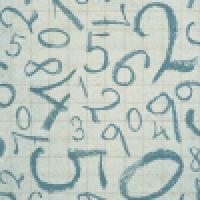
Struggling with your maths?
If you are, then you may be one of the 5 to 7% of the population suffering from dyscalculia, the mathematical equivalent of dyslexia. But unlike many dyslexia sufferers, you probably haven't received the help you need to cope with your condition. As a recent article published in the journal Science points out, dyscalculia is the "poor relation" of dyslexia: few people are even aware of its existence and there's a gaping discrepancy in the levels of funding awarded for research into the two conditions. The authors of the article recommend ways in which sufferers can be supported, through both teaching and specialist software tools, based on new insights into the neuroscience of dyscalculia. But they also warn that more research is essential if we are to come to grips with the condition.

Dyscalculia sufferers have trouble making sense of numbers.
Dyscalculia is a severe disability in performing basic arithmetic. Indeed, it may not even effect sufferers' other mathematical abilities: there are people with severe dyscalculia who are very good at geometry or high-level computer programming. But low numeracy skills come at a high personal cost to sufferers. The authors of the Science article quote a large study published in 2005, which showed that people with low numeracy levels "earn less, spend less, are more likely to be sick, are more likely to be in trouble with the law, and need more help in school."
The personal suffering in turn translates into a measurable cost to the nation. "Dyscalculia is [...] a very heavy burden on the state, with the estimated cost to the UK of low numeracy standing at £2.4 billion," says Brian Butterworth, co-author of the article and a member of the Centre for Educational Neuroscience at University College London. "Nevertheless, there are only cursory references to the disorder on the Department of Education website — no indications are offered for help either for learners, teachers or parents. It's as if the government does not want to acknowledge its existence."
So what can we do to help people suffering from dyscalculia? Current research suggests that at its root, dyscalculia is down to a lack of understanding of simple number concepts, in particular the link between numbers and magnitude. "[Sufferers] do not intuitively grasp the size of a number and its value relative to other numbers," say the authors in the paper. "This basic understanding underpins all work with numbers and their relationships to one another." Sufferers often have difficulties with performing even simple tasks, like enumerating the number of objects in a set or comparing the size of two arrays of dots.
This hypothesis is supported by results from neuro science. Brain imaging studies have shown that regions of the brain known as the intraparietal sulci (IPS) are most heavily implicated in arithmetical and numerical processes (there are two of these sulci, one in each side of the brain, located in the parietal lobes). Evidence suggests that the IPS are responsible precisely for representing the magnitude of symbolic numbers. In individuals without dyscalculia the IPS are implicated in both simple and more complex arithmetical tasks and even when we're only retrieving a memorised mathematical fact such as 2+8=10. In dyscalculia sufferers on the other hand, the IPS are less developed and dyscalculic children use it less during arithmetical tasks than others.

The IPS is located on the lateral surface of the parietal lobe, shown in yellow.
The IPS play a strikingly prominent role, but other areas of the brain are involved too. In fact, studies have shown that there's an age shift in the brain areas used for more complex arithmetical tasks. As we get older, emphasis shifts away from areas that control executive function and working memory towards areas that process symbolic forms. This reflects a fact we're all familiar with: mastering algebra makes your calculations more efficient because you can represent a whole class of problems by one symbolic formula. In terms of dyscalculia, this age shift suggests that experience can influence the development of brain function, opening the door to therapeutic intervention.
What do these results mean for education? Currently in the UK low numeracy is addressed by specialist teachers working with children to identify their conceptual gaps and then trying to bridge each gap though individual support. But neuro science suggests another approach: "Rather than address isolated conceptual gaps, remediation should build the foundational number concepts first," say the authors of the Science article. In other words, conceptual gaps can be avoided by making sure the basic underlying number concepts are understood. When assessing the abilities of individual children, the authors recommend to pay special attention to set enumeration and comparison "to differentiate dyscalculia from other causes of low numeracy".
Special needs teachers' time is expensive, so the authors recommend using specialist software that can adapt to individual students' needs. "Adaptive, game-like programs that focus on making numbers meaningful, emulating what skilled [special needs] teachers do, can help learners practice beyond the classroom and build the basic understanding they need to tackle arithmetic," says Diana Laurillard, another co-author of the paper and a member of Centre for Educational Neuroscience at University College London.
Whether or not these interventions will work remains to be seen. More research is needed, both into the neurosience of dyscalculia and into how to help people overcome it.
Comments
Anonymous
Does anyone know of any such software?
Marianne
The authors of the article in Science mention two examples of adaptive games to help dyscalculia sufferers, Graphogame-Maths and Number Race http://www.unicog.org/main/pages.php?page=NumberRace
Anonymous
Is it available anywhere? I only find the literacy game at GraphoGame